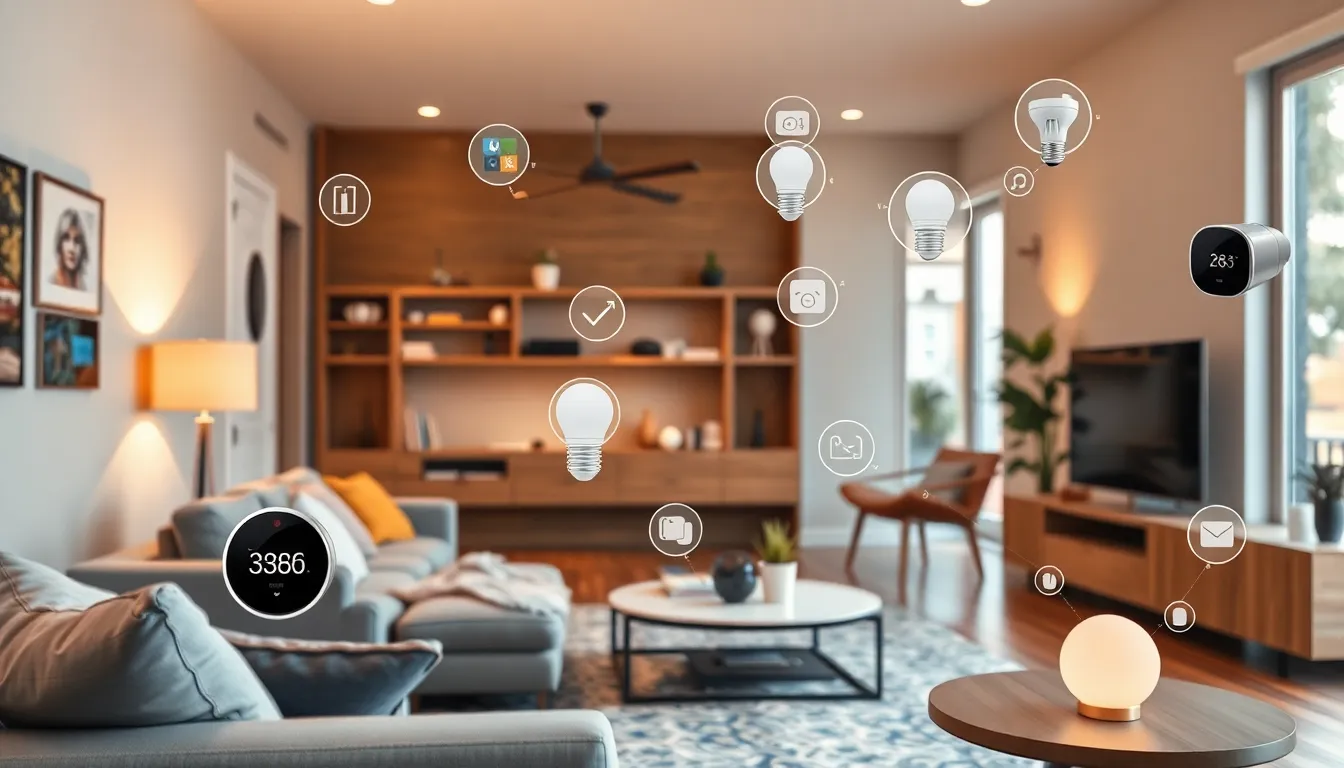Table of Contents
ToggleIn a world where toasters can tweet and refrigerators can order groceries, the Internet of Things (IoT) has taken the spotlight. But behind this tech wonderland lies a maze of protocols that keep everything talking smoothly. Think of IoT protocols as the unsung heroes of the smart device revolution—like the calm referee in a chaotic soccer match, ensuring every device plays by the rules.
Understanding these protocols is crucial for anyone diving into the IoT universe. They dictate how devices communicate, share data, and ultimately make our lives easier. From MQTT to CoAP, each protocol has its quirks, much like a quirky uncle at family gatherings. So buckle up and prepare to navigate the fascinating world of IoT protocols, where connectivity meets creativity and convenience reigns supreme.
Overview of Internet of Things (IoT) Protocols
IoT protocols facilitate communication among smart devices, enabling seamless data exchange. Various protocols exist, each designed for specific applications and scenarios. For instance, MQTT (Message Queuing Telemetry Transport) is lightweight, ideal for low-bandwidth and high-latency network environments. Many developers prefer MQTT due to its efficiency in connecting remote devices.
CoAP (Constrained Application Protocol) operates similarly to HTTP but is tailored for constrained environments, making it suitable for IoT applications where resources are limited. This protocol excels in devices needing minimal power consumption, ensuring longevity and reliability.
Other notable protocols include HTTP (Hypertext Transfer Protocol), a staple for web communication, and WebSocket, which supports real-time data transfer. Each serves unique functions that enhance IoT connectivity.
Security protocols such as TLS (Transport Layer Security) protect data integrity and privacy while devices communicate. Employing robust authentication and encryption methods remains crucial for maintaining secure connections.
Understanding these IoT protocols is essential for leveraging IoT technology effectively. Every protocol, from MQTT to CoAP, plays a significant role in how devices connect and communicate, ultimately improving user experiences. These technologies contribute to the advancement of smart environments, linking devices seamlessly and efficiently.
Key Protocols in IoT

Understanding key IoT protocols is vital for effective device communication. Several protocols serve specific functions, enhancing connectivity between smart devices.
MQTT
MQTT stands for Message Queuing Telemetry Transport. This lightweight protocol excels in low-bandwidth scenarios, making it suitable for remote device communication. Developers favor MQTT for its efficiency in high-latency environments. Its publish/subscribe model allows for easy management of device connections, ensuring reliable message delivery. Additionally, MQTT’s small header size conserves bandwidth, which is crucial for IoT applications. This characteristic makes it a top choice for telemetry applications and overall IoT projects.
CoAP
CoAP, or Constrained Application Protocol, targets devices with limited resources. Designed to work efficiently in constrained environments, it supports low-power operations essential for IoT. CoAP adheres to a client-server model and utilizes UDP as its transport layer. This approach reduces overhead and allows rapid data exchanges. Furthermore, CoAP provides built-in features for resource discovery and caching, enhancing the efficiency of IoT applications. Developers often leverage CoAP for smart grid and home automation systems due to its lightweight design.
HTTP/HTTPS
HTTP, or Hypertext Transfer Protocol, is the foundation of data communication on the web. Though primarily used for web traffic, it has applications in IoT as well. HTTPS, its secure variant, encrypts data sent between devices, ensuring privacy and integrity. IoT devices employ HTTP/HTTPS for tasks like firmware updates and sending data to cloud servers. Despite its larger header size compared to MQTT or CoAP, its ubiquity simplifies integration with existing web applications. Consequently, developers may choose HTTP/HTTPS when security is a paramount concern in IoT solutions.
Comparison of IoT Protocols
Understanding the differences between IoT protocols aids in selecting the right one for specific applications. Each protocol has unique performance metrics and use cases that influence its effectiveness.
Performance Metrics
Latency, bandwidth efficiency, and energy consumption are key performance metrics for IoT protocols. MQTT stands out for its low latency and efficient data transmission, especially in unreliable networks. CoAP excels in conserving energy, making it ideal for battery-operated devices. HTTP, while widely used, may struggle in low-bandwidth scenarios but prioritizes data integrity with HTTPS. Reliability also varies; MQTT’s publish/subscribe model ensures message delivery even in high-latency environments, whereas TCP/IP-based protocols like HTTP offer robust connections but higher overhead.
Use Cases
Specific use cases highlight the strengths of different IoT protocols. MQTT is well-suited for applications in smart home automation or remote monitoring, where reliable message delivery is crucial. CoAP serves well in sensor networks or smart agriculture, where power efficiency matters. HTTP supports web-based applications like cloud services, connecting devices directly to web servers. WebSocket enables real-time communication for interactive applications such as smart home control. Understanding these applications helps in effectively integrating protocols into IoT solutions.
Challenges in IoT Protocols
IoT protocols face various challenges that can hinder their effectiveness in connecting devices efficiently. Two significant issues are security concerns and scalability challenges.
Security Concerns
Security remains a top priority within IoT protocols. Many devices lack adequate security measures, leading to vulnerabilities that malicious actors can exploit. Protocols often transmit sensitive data over unsecured channels, risking data breaches and unauthorized access. The use of Transport Layer Security (TLS) can enhance data integrity and privacy, but not all implementations include such measures. As devices proliferate, ensuring robust security across all endpoints becomes increasingly complex. Addressing these vulnerabilities is essential for fostering trust in IoT ecosystems.
Scalability Issues
Scalability presents a critical challenge as IoT deployments expand. Protocols need the ability to handle an increasing number of devices without sacrificing performance. Most existing protocols face limitations in managing high volumes of concurrent connections, leading to potential bottlenecks. MQTT excels in low-latency environments, yet it can face challenges when scaling to thousands of devices simultaneously. CoAP, while efficient for constrained devices, may struggle with interoperability in larger networks. Achieving seamless scalability remains imperative for the continued growth and reliability of IoT applications.
Future Trends in IoT Protocols
Emerging trends in IoT protocols highlight the shift towards enhanced security and interoperability. As IoT device proliferation continues, developers prioritize protocols that ensure robust security measures. Emerging standards focus on encryption techniques, with Transport Layer Security (TLS) playing a vital role in data integrity and privacy.
Adoption of IPv6 is increasing due to its ability to support a vast number of devices without IP address limitations. This trend facilitates efficient communication and scalability across extensive networks. Protocols integrating IPv6 can better manage and route data, improving overall performance.
Another trend involves edge computing, which allows data processing closer to the data source. This reduces latency and bandwidth usage, maximizing efficiency. Protocols designed for edge computing emphasize lightweight operations, enhancing responsiveness for time-sensitive applications.
Also noteworthy is the rise of machine learning integration with IoT protocols. This development enables smarter decision-making and predictive analytics by analyzing data patterns quickly. As machine learning advances, protocols that support real-time data streams and rapid processing will gain traction.
Focus on interoperability remains crucial, enabling devices from different manufacturers to communicate seamlessly. Protocols that adopt open standards facilitate collaboration between devices, enhancing user experiences across various ecosystems. Greater interoperability paves the way for expansive smart environments.
In the realm of energy efficiency, new protocols are being designed to minimize power consumption, particularly for battery-operated devices. CoAP’s lightweight nature exemplifies this trend, making it suitable for environments with strict energy constraints. Innovations in energy-efficient protocols promote longer device lifespans and lower operational costs.
These trends in IoT protocols emphasize the importance of security, scalability, and energy efficiency, shaping the future landscape of IoT technology.
The landscape of IoT protocols is rapidly evolving as technology advances. Understanding the nuances of these protocols is essential for developers and businesses aiming to harness the full potential of IoT. With a focus on security scalability and energy efficiency future protocols will likely address current challenges while enhancing device communication.
As the demand for smart devices grows the importance of selecting the right protocol becomes more critical. This ensures seamless interaction between devices and a better user experience. Staying informed about trends in IoT protocols will empower stakeholders to make informed decisions that drive innovation and improve connectivity in an increasingly interconnected world.







